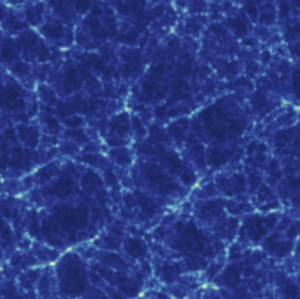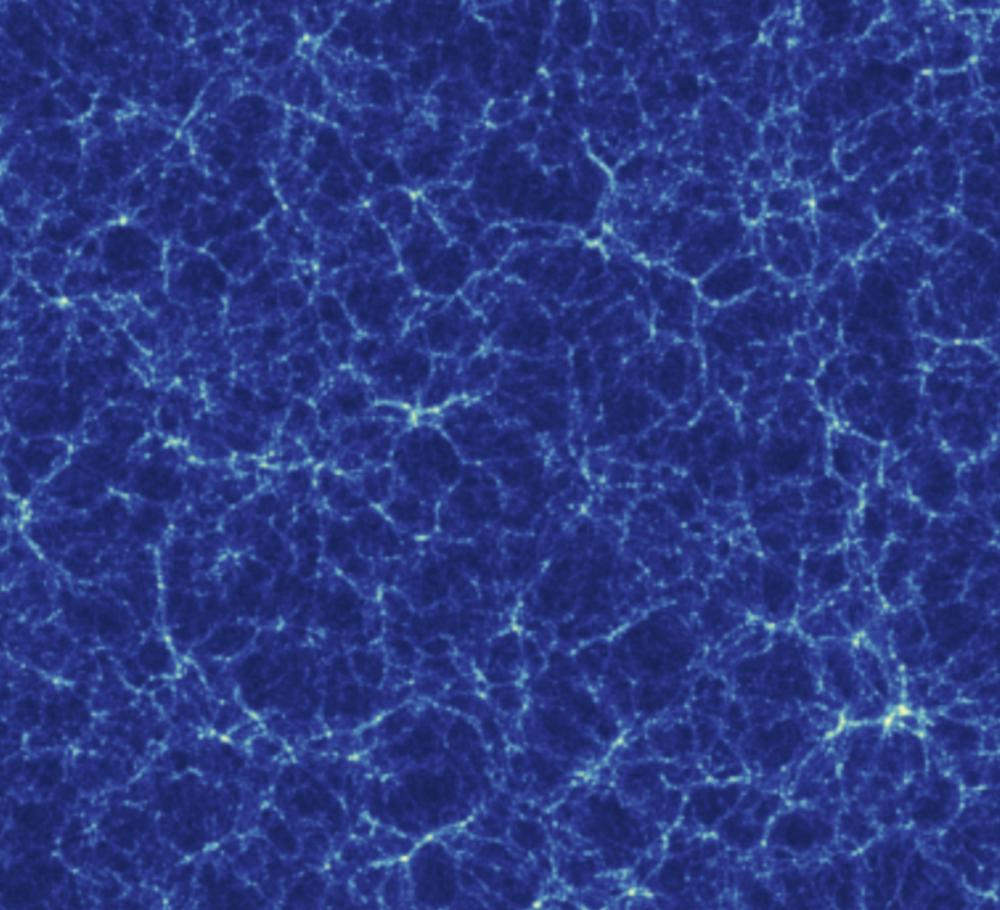Universal Formula for Cosmic Voids
Most of the matter in the Universe consists of the mysterious dark matter, and cosmologists would like to better understand how it is organized in space. Writing in Physical Review Letters, a team presents detailed computer simulations of the large-scale, bubble-like voids that exist in dark matter. They found that the uniform average shape of these voids seen in previous studies extends well beyond their central regions and also that the uniformity includes voids of a wide range of sizes and ages. The team’s universal formula for the density profile of dark matter in voids could be used to probe the nature of dark matter and neutrinos and perhaps even to test the accuracy of Einstein’s theory of gravity.
Scarcely anything is known about dark matter except that, apart from its gravitational effects, it hardly interacts with ordinary matter or light. Even so, researchers can still conduct computer simulations to see how dark matter distributes itself.
Earlier simulations have shown that a uniform dark matter “gas” collapses under its own gravity into a tangled web of sheets and filaments that is permeated by relatively empty voids [1,2]. In fact, in these simulations the voids make up most of the volume of the Universe, with thin “walls” of the dark matter separating one void from another. These dark matter formations appear to have seeded the growth of stars and galaxies, giving rise to the large-scale structure of the visible Universe.
Nico Hamaus of the Paris Institute of Astrophysics and his co-workers have now carried out simulations that probe the density profiles of dark matter voids in more detail than previous studies. Their simulations contained more than eight billion dark matter particles. They omitted ordinary matter, since there is so little of it compared with dark matter, but they included dark energy, which influences the continuous expansion of space.
Just as in previous studies, the dark matter clustered and created voids having a wide range of shapes and sizes. Others have found that the central regions of these voids have a universal dark matter density profile that is spherically symmetric when averaged over all voids, and which rises smoothly from the center. But Hamaus and his colleagues went farther. They found that the universal profile continues to a density maximum in the walls that separate voids and then declines again as one enters the next void. The team also found that this simple shape fit voids of all sizes and could be adapted to voids from different eras in cosmic history.
What’s more, the team found that the profile could be fitted empirically with a rather simple formula that contains just two parameters. In a companion paper [3], the team shows that a simulation of the galaxy distribution produces essentially the same kind of void profile, even though galaxies don’t track the dark matter perfectly.
As the observational data improves, it should be possible to make precise comparisons with the galaxy distribution seen by astronomers and look for discrepancies, says Hamaus. “Any differences may hint at inconsistencies in our assumptions about dark matter, or dark energy, or gravity,” he explains. For example, the team assumed that dark matter is “cold”—the particles move slowly compared with the speed of light. But if dark matter is warmer, with more energy, Hamaus says that the density profile and other properties of voids will be different. The presence of hypothetical, massive types of neutrino would also have measurable effects on the void structure.
The findings offer “a way of probing cosmology and modified gravity,” according to cosmologist Joseph Silk of Johns Hopkins University in Baltimore. The latter, says Silk, is especially intriguing. “While Einstein’s theory of gravity works well in over-dense regions of the Universe, from the Solar System to clusters of galaxies, many argue that something is missing on the very largest scales,” he says. “Voids, and especially super-voids, are large regions where modified gravity may lead to measurable differences from Einstein’s theory.”
–Philip Ball
Philip Ball is a freelance science writer in London. His latest book is How Life Works (Picador, 2024).
References
- J. M. Colberg, R. K. Sheth, A. Diaferio, Liang Gao, and Naoki Yoshida, “Voids in a ΛCDM Universe,” Mon. Not. R. Astron. Soc. 360, 216 (2005)
- E. Ricciardelli, V. Quilis, and S. Planelles, “The Structure of Cosmic Voids in a ΛCDM Universe,” Mon. Not. R. Astron. Soc. 434, 1192 (2013)
- P. M. Sutter, G. Lavaux, N. Hamaus, B. D. Wandelt, D. H. Weinberg, and M. S. Warren, “Sparse Sampling, Galaxy Bias, and Voids,” Mon. Not. R. Astron. Soc. 442, 462 (2014)





